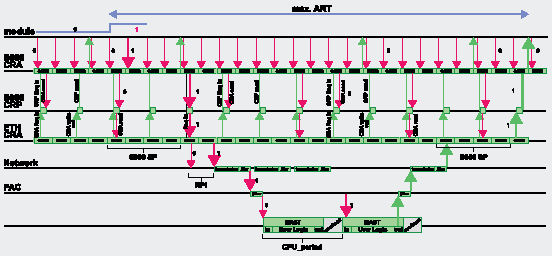In a Quantum system, the CPU schedules the CRP directly over the backplane.
In an M580 system, the CRP communicates with the 140CRA31908 module that is scheduled by the CPU over Ethernet/IP.
Quantum and M580 systems, therefore, use different methods to manage I/O points and the application response time:
-
Quantum: Communication exchanges between an S908 CRP module and a Quantum CPU are done periodically within the cycle time and sequentially remote drop by remote drop. That means the Quantum CPU does not scan the next Quantum S908 remote drop until data for the current remote drop are available. It also means the CPU does not execute the application until all remote drops are refreshed.
-
M580: In an M580 system, the input data are sent at a predetermined time interval based on the request packet interval (RPI). The RPI is set (by default) to one-half of the cycle time (if periodic) to synchronize the data with the task.
NOTE:
-
For more information, refer to the description of application response time in the Modicon M580 Hot Standby, System Planning Guide for Frequently Used Architectures.
-
When you import a Quantum application that includes section schedulers and segment schedulers, the order of the logic may not conform to the MAST task. Contact Schneider Electric for more information.
-
The local I/O modules are managed in the Quantum S908 remote drop, but the worst-case ART can be increased by 40ms when the 140CRA31908 module is not the I/O master in an S908 remote redundancy configuration.
From this illustration of the S908 Quantum ART, we can deduce a simple formula to quickly estimate the maximum ART in a Quantum S908 system:
|
Mode
|
Formula
|
|
cyclic
|
Max ART (ms)= (2*CPU_cycle) + 8.8ms
|
|
periodic
|
Max ART (ms)= CPU_period + CPU_cycle + 8.8ms
|
Values:
-
8.8ms: This constant value represents the maximum CRA processing time.
-
CPU_cycle: CPU_cycle is composed of the real time that is required to execute the application and the S908 scan period, a maximum of 4ms per remote drop in the worst case (an extended remote drop with high number of words).
-
CPU_period: CPU_period is composed of the CPU_cycle completed by an overhead to reach the period time configured by the user. Usual recommendation is to have a max CPU_cycle equal to 80% of the configured period.
From this illustration of the S908 M580 ART, we can deduce a simple formula to quickly estimate the maximum ART in an M580 system:
|
Mode
|
Formula
|
|
cyclic
|
Max ART (ms)= CRA->Scanner RPI + 2*CPU_cycle + 8.8ms + 2*S908_scan
|
|
periodic
|
Max ART (ms)= CRA->Scanner RPI + (CPU_cycle + CPU_period) + 8.8ms + (2*S908_scan)
|
Values:
-
8.8ms: This constant value represents the maximum CRA processing time.
-
S908_scan: S908_scan can reach up to 4ms per remote drop (worst case of an extended remote drop with high number of words).
-
CPU_cycle: CPU_cycle is the real time required to execute the application and does not include S908_scan time.
-
CPU_period: CPU_period is composed of the CPU_cycle completed by an overhead to reach the period time configured by the user. It is recommended to use a maximum CPU_cycle equal to 80 percent of the configured period.
Thanks to M580 additional processing power, we estimate that the cycle execution can be reduced from three to five times compared to Quantum and then compensate in most realistic use cases the Ethernet/IP additional network layer compared to pure S908 network performance. Indeed, in a periodic execution mode, the user will be able in most case to set a period at least three times shorter on an M580 CPU compared to Quantum CPU for the same application. Some exceptions could yet exist for complex systems (especially redundant systems) and could require finer analysis of the application to get the expected performance factor between M580 and Quantum.
The following tables show sample ART calculation formulas.
Periodic mode example:
|
System
|
Characteristics
|
Maximum ART Formula
|
|
Quantum
|
|
CPU_period + CPU_cycle + 8.8 = 150 + 120 + 8.8 = 278.8ms
|
|
M580
|
Same as above, using an M580 CPU in optimized periodic mode (period = 1/3 of Quantum period, with the worst case being 50ms and the cycle time value being 80 percent of the period, which is the recommended cycle time)
|
CRA->Scanner RPI + CPU_period + CPU_cycle + 8.8ms + 2*S908_scan = 25 + 50 + 40 + 8.8 + 2*(16*3) = 219.8ms
|
Cyclic mode example:
|
System
|
Characteristics
|
Formula
|
|
Quantum
|
|
2*CPU_cycle + 8.8ms = 2*93 + 8.8 = 194.8ms
|
|
M580
|
Same as above, using an M580 CPU in cyclic mode, the cycle time becomes 25ms (75 = 25ms), with a watchdog time of 40ms (=> RPI = WDT/4 = 10ms).
|
CRA->Scanner RPI + 2*CPU_cycle + 8.8ms + 2*S908_scan = 10 + 2*25 + 8.8 + 2*(6*3) = 104.8ms
|
NOTE: In the case of a CPU or 140CRA31908/CRP
switchover, the ART can increase by two PLC scans.

